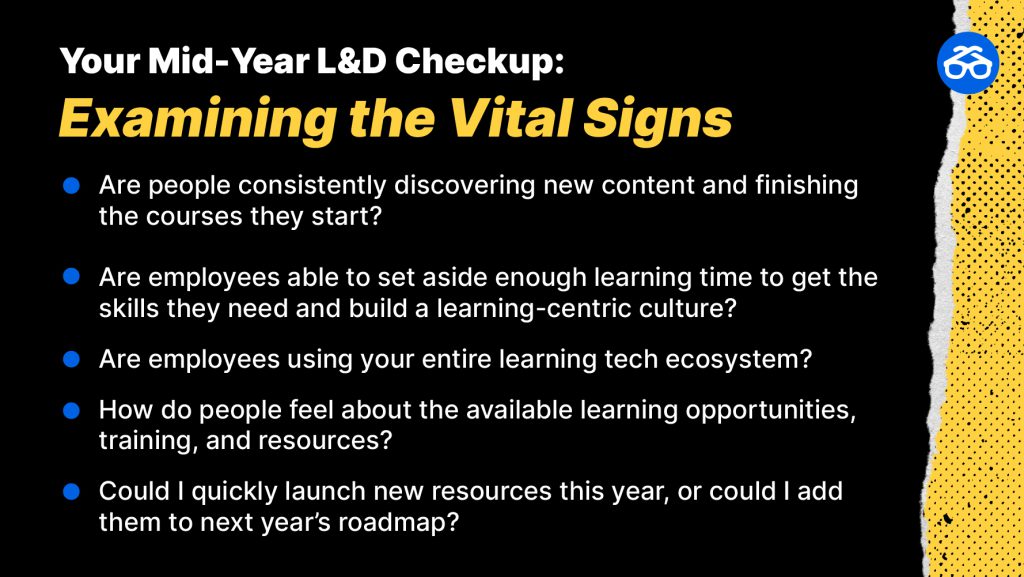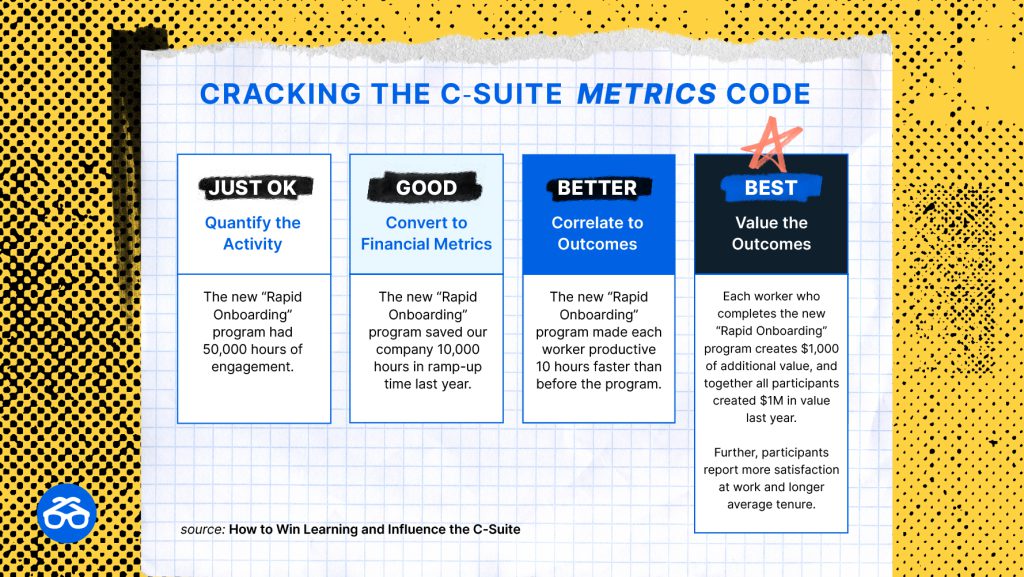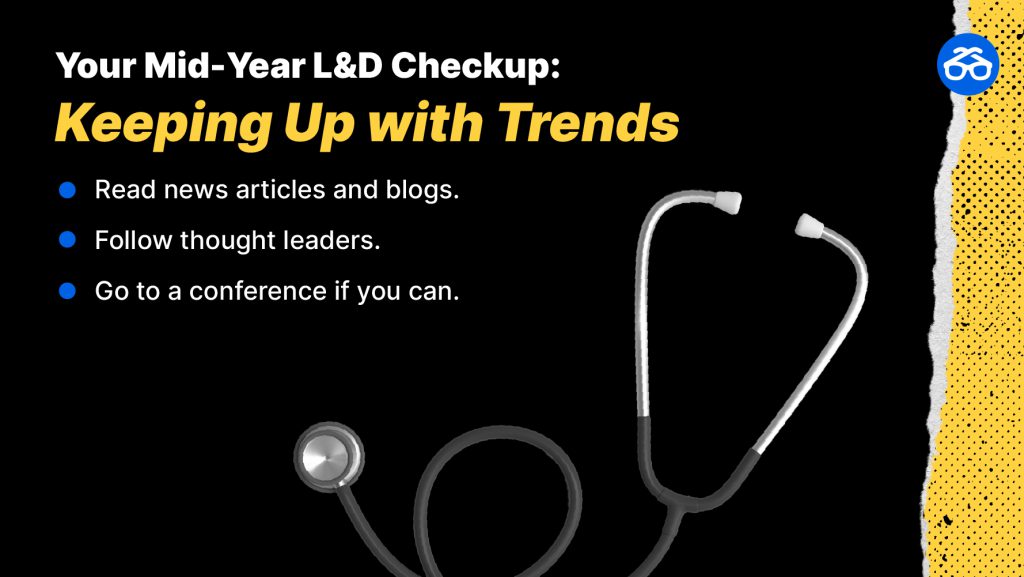Summer’s ending, which means the end of 2024 draws closer and closer—and now’s the perfect moment to take the true measure of your L&D program’s health.
A mid-year checkup now will give you plenty of time to course correct if things aren’t going quite as planned, to fine-tune so you get even better results if they are, and to walk away with some fresh ideas to help you start planning for 2025.
How are your people progressing? Are your initiatives still aligned with business goals, so learning can be as impactful as possible? Are you and your L&D colleagues staying up-to-date with your own personal and team development? A mid-year checkup can answer these key questions and more.
Checking Program Vitals
At Degreed, we’re all about focusing on learning metrics that measure business-critical impact. Metrics that show how L&D helps drive revenue and cost savings are critical to understanding your long-term successes and sharing those outcomes with your company’s leaders. But before you whip out your ROI of learning stethoscope, it certainly helps to revisit the basics—like whether people are even using your programs.
Start by checking vital signs. Put your program on the scale, take its blood pressure, and ask it to breathe deeply while you listen to its lungs. In other words, shore up those basic learning metrics that give you a picture of your program’s fundamental health.

And remember, these are the metrics will help you spot problem areas you can address long before your EOY review:
Skill Ratings
You and your people can rate skills in several ways—including self ratings, manager and peer ratings, skill assessments, and even a chat with AI. Often, a combination of methods delivers the best picture of an individual’s skills, which is why Degreed provides multiple ratings methods. Once individual skills are rated, you can look at the data holistically across departments and your company, by the programs that teach the skills considered, and over time.
Social Learning
If employees aren’t learning socially, it’ll stymie your efforts to build skills. So keep an eye on how often employees share learning content with others, follow experts, connect with mentors, or participate in a group learning activity.
Content Completions
Course completions don’t necessarily mean employees are learning, but high engagement is a good start for new programs. If you see low course completions, it might be a sign that employees don’t find content useful, or that courses aren’t aligned with business goals.
Learning Hours
If employees aren’t spending much time learning, they’re not going to reap the benefits of your programs, and neither will your company. Dig into strategies that help employees learn more in the flow of work—or ways to get more buy-in for more dedicated learning time. Employees need support from their managers especially. You might need to scrutinize your company culture and start advocating for more learning-centric values.
Active Users Month Over Month
Choosing the right technology solutions is challenging, but one sign that you’ve chosen well is employees use them a lot. This is your engagement story. If people aren’t using a solution, dig deeper to find out why and consult with your vendor on ways to course correct—or consider trying a new solution with next year’s budget.
Employee Sentiment
Employee surveys can’t tell you how your initiatives affect the business, but understanding how they affect employees can help you get more people learning—and that’s how you impact the business as a whole. Find out how people feel about their available learning opportunities—and what they want more of.
Learning engagement metrics like these are an excellent way of checking program health, and they can help you find potential problems early. But like the vital signs your doctor gathers at your annual physical, they don’t mean much by themselves. Your weight, for example, doesn’t indicate whether you can run a 5K or play with your kids without running out of steam.
Revisiting Learning Strategies
The best doctors do more than check your vital signs during your annual physical. They inquire about your health goals and make sure test results show you’re headed in the right direction. Similarly, high engagement and lots of learning hours are great. But if they’re not helping achieve business goals, it could be time to course-correct.
Look at the holistic health of L&D. Explore overall skill growth across your organization. Consider your end-of-year goals—and the company’s even longer-term goals. Are you taking consistent steps toward them?
Get creative too. If you’re not seeing the impact you’d like, start brainstorming ways to change that. Look to the areas where you see gains, and find ways to bring that success to other areas or programs.
Go beyond vital signs, check on metrics that show how you’re driving business results. Employee retention and internal mobility metrics are great for tracking general L&D impact, but you can get more specific too.

If you launched a sales skills initiative, plot sales growth and sales cycle length alongside the growing number of associates who’ve developed relevant skills. If you launched a management academy, look at internal promotion rates.
Moving Skill Targets
A lot can happen in half a year, especially now that rapidly evolving technologies like AI and automation are impacting nearly every industry. There’s a good chance your company’s goals—or at least, the plans for achieving them—have changed since January 1.
A robust skill development program can help your business stay agile—but only if L&D can pivot quickly to keep up with changing development needs.
As you conduct your mid-year checkup, look for ways the business has pivoted—and how L&D can respond.
Realign with company goals if necessary. The middle of the year is a good time to connect with executives and managers, find out how they see your progress toward key initiatives, and capture their changing needs.
Next, think through how you can pivot. Consider completing or revisiting the L&D business alignment exercise in our ROI of learning guide How to Win Learning and Influence the C-Suite.

Staying Up to Date
L&D trends can move as fast as the calendar, and that means quickly. As you take the pulse of your L&D initiatives and map them to your latest business goals, remember to also consider industry changes and trends. You might find better ways to achieve success—or reasons to pivot.
Like doctors who read new medical studies in order to give the best advice, savvy L&D professionals track industry trends in order to provide up-to-date development recommendations. They do this by reading articles and blogs, following thought leaders, and going to conferences when possible.
- Read news articles and blogs. Look to trade magazines, professional organizations, and edtech companies. (And we’d be remiss if we didn’t also suggest the Degreed At Work Blog homepage, as well as our ongoing AI-focused blog post series Degreed Experiments.)
- Follow thought leaders and other L&D professionals, especially on LinkedIn. Join the conversations they inspire.
- Go to a conference or two throughout the year, if possible. (We, of course, think Degreed LENS is excellent, and there are many others.) Be strategic about which conferences you choose. If you discover any L&D deficiencies during your mid-year checkup, the right conference could help you fix what’s ailing.
Here are some trends we’ve been recently following:
- Applying AI to L&D
- More companies becoming skill-based organizations
- The rise of learning academies
- An increased focus on frontline worker training

When you embrace a new idea or trend that might help you achieve your goals, mid-year can be a great time to test it out. You’ll start generating some baseline performance data you can quickly build upon next year, so experiment and see if you can optimize anything.
Streamlining Your Mid-Year Checkup
Once you launch a new L&D program, it’s tempting to leave it behind and focus on the next phase of your learning strategies.
But even the best-planned program needs a check-up to ensure it’s on-track.
So don’t wait. You could miss out on opportunities to adapt to the way employees are using your content. You might miss changes in the market. Or you might miss aligning with evolving company goals.
Learn more.
The Degreed Professional Services team partners with business leaders and learning pros to explore learning strategies, technology goals, and questions. Book a free, private consultation.

